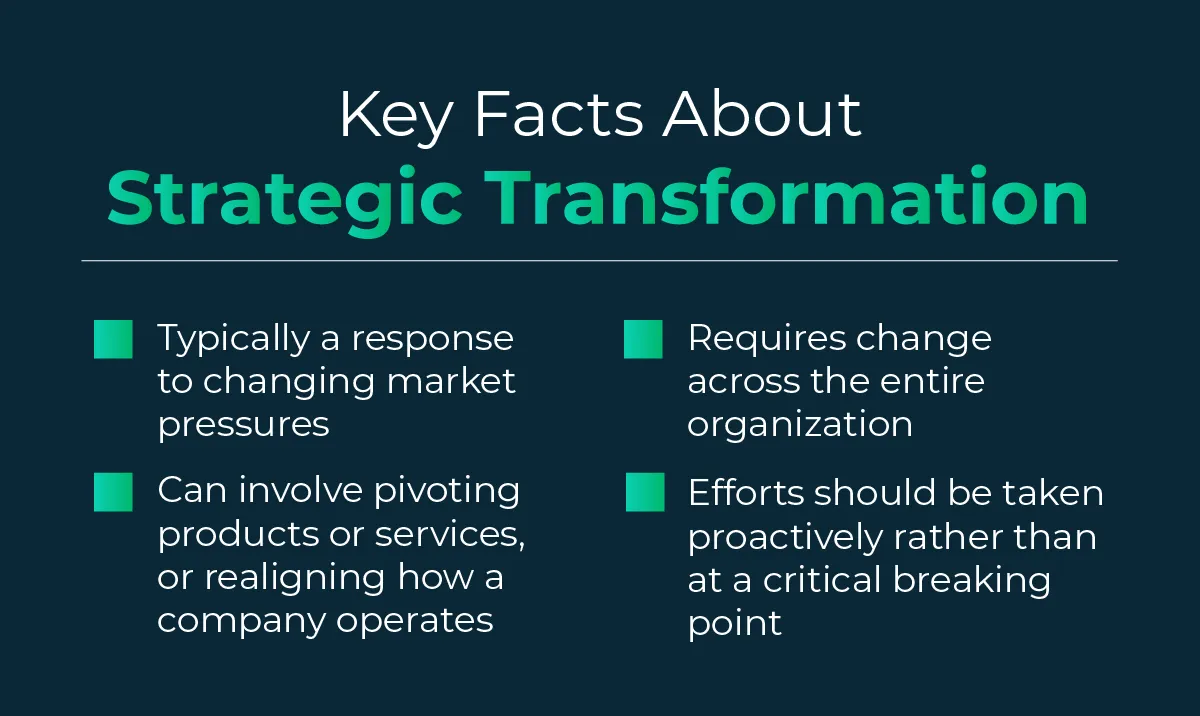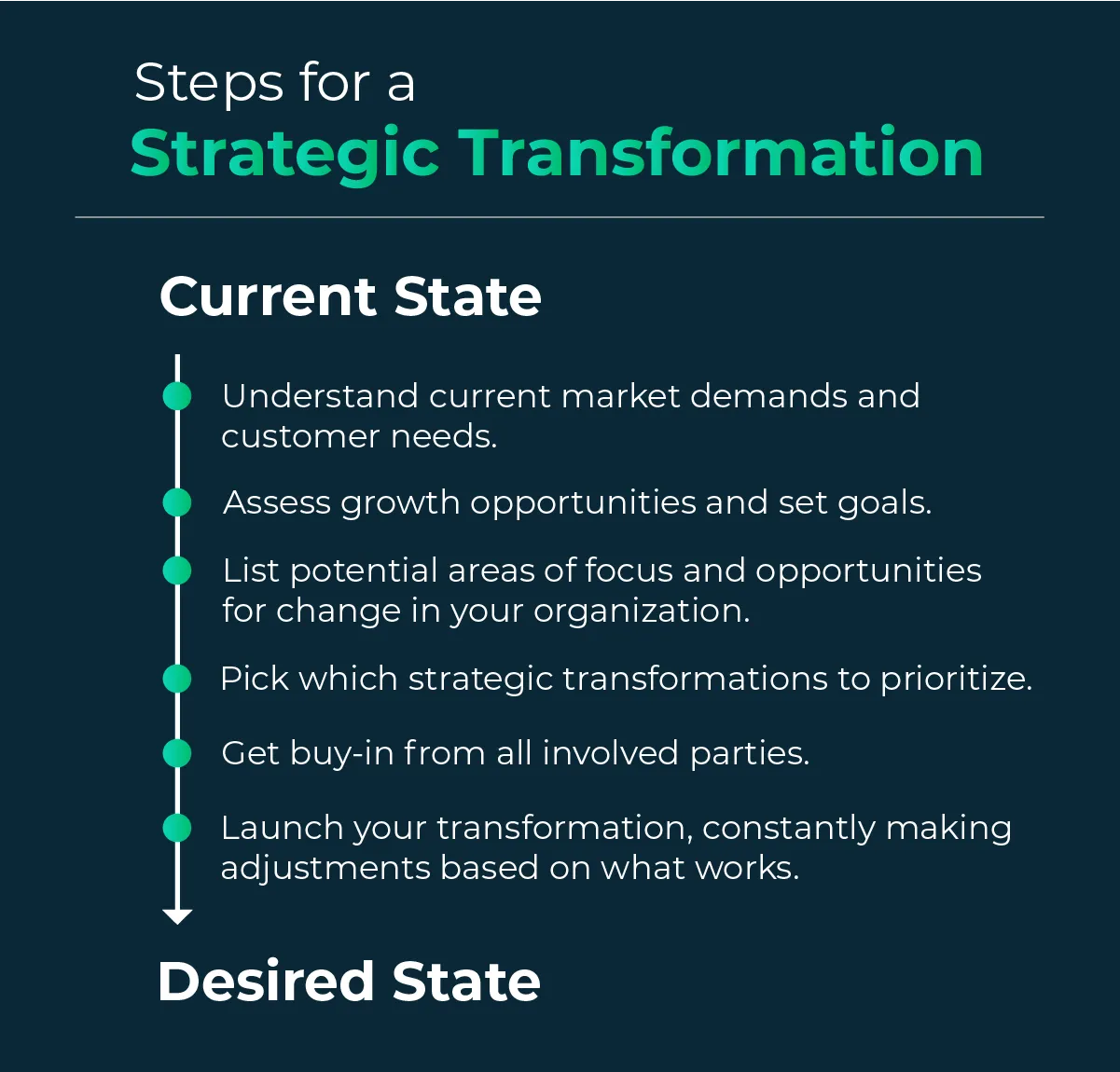Everything You Need to Know About Strategic Transformation

In a competitive, ever-changing economy, strategic transformations are essential to most organizations’ ability to survive—and thrive—amid changing consumer preferences and marketplace pressures. Yet, according to McKinsey & Company, 70% of large-scale corporate transformations fail.
The implications are clear: the ways many organizations approach transformations aren’t working.
So what is a strategic transformation? And how can organizations complete them successfully to remain relevant in the marketplace?
What Is Strategic Transformation?
While different industries and organizations offer varying strategic transformation definitions, several key factors are consistent.
Companies undertake strategic business transformations in response to significant and sustained pressures from the market. The process may involve pivoting products, services, or offerings, or it may mean realigning how a company does business to maximize consumer satisfaction and shareholder returns. Ideally, these efforts are undertaken proactively rather than at a critical breaking point.
A true strategic transformation is not limited to isolated or cosmetic changes to a single product or operational strategy. Rather, it involves reimagining and reconfiguring the way a company operates across the entire organization and bringing all employees along for the journey. Sometimes, transformations are primarily operational, and sometimes they involve a complete pivot, like when Nokia shifted from making tires to producing mobile phones and then to software and communications products.
Why Is Strategic Transformation Important in Today’s Workplace?
The last several years have brought unprecedented pressures to the global marketplace. The sustained impacts of the COVID-19 pandemic, as well as economic shocks from Russia’s war in Ukraine and widespread inflation, have forced organizations to embrace transformation strategy at a previously unimaginable pace.
For many organizations, the sudden shift to hybrid and remote-first workplaces rapidly accelerated planned transformation efforts. In fact, McKinsey found that digital transformation efforts in particular took place seven years faster than planned in response to the pandemic. This was primarily to ensure that critical functions (like employee payroll) were maintained. Rapid changes in employee and customer expectations have also forced companies to adopt new approaches.
Alongside the shift to digital, the advent of COVID-19 was the first of several shocks to the global supply chain that highlighted weaknesses in the dominant “just-in-time” approach to manufacturing and distribution. Shipping disruptions caused by the pandemic, followed by supply chain issues related to the war in Ukraine and global workforce shortages, have forced companies to hold increased inventory. As a result, costs have risen, leaving companies to find new ways to cut costs and streamline operations.
Types of Strategic Transformation
Strategic transformation can take many forms, and often a broad organizational transformation involves several overlapping types. These may include (but are not limited to) the following.
Digital Transformation
A digital transformation involves integrating technology across an organization to change the way it operates internally and externally presents its products or services. Today, most strategic transformations involve at least some digital element. For example, automotive companies transitioning to producing electric vehicles will need to account for the increased importance of software. At the same time, manufacturing organizations may pivot to integrate artificial intelligence, 3D printing, and other new technologies into their operations.
Marketing Transformation
Marketing transformations are often directly tied to broader digital transformation efforts. A comprehensive marketing transformation involves the entirety of a company’s marketing and sales infrastructure. It provides all employees with the upskilling and knowledge they need to reach customers in the digital environments where they spend time.
Data Transformation
The increasing importance of data science and advanced analytics will require many organizations to implement transformation strategies. An effective data transformation does not involve simply creating a siloed data function. Rather, it requires developing data skills and literacy across the organization to ensure all business decisions are grounded in data and that workers understand how to use data to inform day-to-day operations.
Leadership Transformation
A comprehensive strategic transformation effort may involve changes to a company’s leadership structure or to its leaders themselves. Even if personnel changes are not involved, leadership transformations can take place when a company intentionally changes the methods and tactics it uses to lead, manage, and inspire its employees. Often, these types of transformations involve sending leaders through targeted training programs to ensure they are all on the same page and in sync on tactics and strategy.
Sustainability Transformation
Increasingly, corporations are paying attention to the impacts of climate change—both as part of efforts to improve their own impacts on the world and also because of pressing business interests. Sustainability transformations involve looking at every aspect of how a business operates to reduce environmental impacts while improving outcomes. Companies need to ensure employees at all levels of the business are prioritizing environmentally-friendly choices and have a shared framework for identifying potential improvements.
Steps to Launch a Strategic Transformation
Successful strategic transformations require careful planning and implementation. Key steps will vary widely from company to company but at a very high level include the following.
1. Ask Questions
Successful transformations are grounded in a comprehensive understanding of market demands. Organizational leaders should conduct a thorough assessment of their competitors and customers to identify areas of misalignment between what the company offers and what the market wants.
2. Expand the Inquiry
Relying on leaders alone for key perspectives can be disastrous. Organizations should engage with employees at all levels, as well as customers from across all targeted segments, to better understand growth opportunities. Think big: McKinsey found that transformations with audacious goals are more likely to succeed.
3. Identify Options
Once the initial discovery phase is complete, leaders should work to identify a broad range of ideas for transformation. At first, the net should be cast as wide as possible, even to include ideas that may not be immediately realistic. Then, leaders can hone in on the most promising ideas and adapt them to meet business realities.
4. Make Choices
Rarely is it possible to pursue all desired changes at once. Once leaders have identified core focus areas, it’s time to make hard choices and pick which strategic transformations to prioritize. Bookmark additional goals for the future.
5. Develop Buy-In
Developing buy-in is one of the most important stages of the transformation process, and failure to do so is a leading cause of problems in the transformation process. From the board of directors to every level of staff, it’s essential to ensure that everyone involved in implementing the transformation plan fully understands its purpose, goals, and tactics. Extensive, effective communication is critical.
6. Iterate
As implementation efforts begin, it will soon become clear that certain initial approaches will work better than others. Effective transformational leaders will quickly recognize areas of weakness and the factors impacting their failures and adapt strategy to improve outcomes.
Launching a Successful Strategic Transformation
A successful strategic transformation is one in which all parties are informed, on board, and committed to making necessary changes.
While most companies seek transformations to increase profitability and remain competitive, effective buy-in and collaboration are the surest indicators they are moving in the right direction.
Build the Skills to Drive Transformation
Are you considering a strategic transformation or preparing to embark upon one? Emeritus Academies offers a unique learning program designed to equip employees across all levels of the organization with the language and tools to drive success.
















